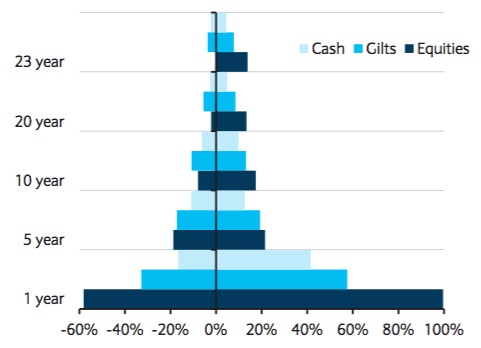When you’re investing in a bear market, it’s easy to forget that share prices can go up as well as down.
This daily volatility scares people off during bull markets, too. It can be hard to watch your net worth fluctuate according to the whims of Wall Street (which is one reason I believe it’s better to focus on your portfolio income).
At least this volatility is potentially making you richer – provided you’re trickling money in regularly over the long-term.
With so-called dollar-cost averaging, you buy more shares when they’re cheaper and less when they’re expensive. The volatility actually improves your returns.
Mike at Oblivious Investor created this three-minute video showing the maths:








Comments on this entry are closed.
Presumably the volatility is not quite so good when you are steadily transferring your investments to cash/annuities.
Dave,
That’s exactly right. Whether you’re dollar cost averaging into or out of the investment, volatility tends to result in a lower average share price. And when you’re the one selling, that’s not a good thing.
@Dave perhaps that’s where you need value averaging 😉
Always puzzled me why people enter the market over many years for their pensions and then come out of it all of a sudden and grouch that annuity values have plummeted. The rational reverse of the slow entry would be a slow annual purchase of part-annuities in a ladder across say ten years from 60 to 70. This also helps with the problem of younger pensioners fearing dying early leaving their estate nothing. The system isn’t set up to favour that at the moment but it’s high time it got changed that way. The single snapshot annuity purchase is the most broken part of the way pensions are done in Britain IMO. Diversification works across time as well as across asset-classes.
@ Ermine: good idea! Why not send it to Steve Webb?
Why can’t I see the video? It just doesn’t appear on the blog
Hmm, it looks like the video has been dropped. Will try to find a replacement — thanks for the heads up!